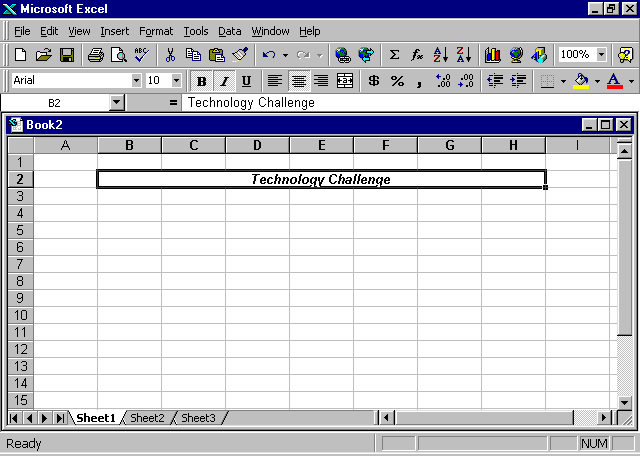What you will learn from this lesson
With Excel 97 you will:
-
Use number formats.
-
Format using the Formatting toolbar.
-
Format numbers in cells.
-
Resize columns.
-
Use the AutoSum button (
 ). ).
-
Format rows and columns.
-
Rotate text on your worksheet.
-
Customize the Formatting toolbar.
What you should do before you start this lesson
-
Start Excel 97.
-
Open a new workbook.
Exploring the lesson
When you enter numbers or text into any cell
in Excel 97, you can format how the information is displayed. You can change
the number to appear as a percentage or in any one of several formats.
Excel can display numbers in many ways.
Any number can be entered as a plain number and then changed into another
format.
Exploring number format
Trying different number formats
-
Click cell B2, type 123456, press enter, and
then click B2 again.
-
On the Format menu, click Cells.
-
On the Number tab, choose Currency. In Decimal
places, click the down arrow until 0 appears, and then click OK.
-
Click B2, in the Formula Bar, type – in front
of 12345, press enter
-
Click cell B2, and click Format Cells.
-
On the Number tab, under Category, click Number,
under Negative numbers, click 1234 in red, and click OK.
-
Close the workbook after saving as Assignment
5.
Entering dates
Displaying numbers as dates and formatting date cells
-
Open the Assignment 4
workbook you created earlier.
-
Click the B column header to select the dates
and all of column B.
-
On the shortcut menu, click FormatCells.
-
On the Number tab, under Category, click Date.
-
Under Type, choose 04-Mar-97.
-
Click OK.
-
On the File menu, click Save.
-
Close the workbook.

Using Formatting toolbar buttons
Using the Formatting toolbar to change cell formats
-
Open a new workbook.
-
Click cell B2, and type Technology Challenge.
-
Press enter.
-
Click and drag cell B2 to cell H2.
-
Click cell H2. On the Formatting toolbar,
click Merge and Center (the little picture next to the dollar sign).
-
Select the words Technology Challenge.
-
Click the Italic button.
-
Click the Bold button.
-
Save as Assignment 6.

Formatting numbers in cells
Excel changes the width of any cell as you
enter the number. It automatically adjusts the width to accommodate your
numbers.
Formatting a cell with the Decrease Decimal and Increase Decimal buttons
-
Open Assignment 6.
-
 In
cell B4, enter 12345678999, and press enter. In
cell B4, enter 12345678999, and press enter.
-
Add a decimal point between 5 and 6, and press
enter.
-
Click B4, and click the Decrease Decimal button
twice.
-
Increase the number four times with the Increase
Decimal button.
-
Save and close the workbook.
Using the AutoSum function
Excel 97 uses some math functions as buttons
on the Standard toolbar. The AutoSum button is displayed as sigma (  ) and is used to calculate the sum of a range of numbers.
) and is used to calculate the sum of a range of numbers.
Totaling numbers
-
Open Assignment 4 saved
earlier.
-
Click the E column header, click the Insert
menu, and then click Columns.
-
Click E6.
-
Click the AutoSum button (
 )
on the Standard toolbar, and verify that the cells selected for summation
are correct. )
on the Standard toolbar, and verify that the cells selected for summation
are correct.
-
Press enter, and note the summation results
in cell E6.
-
Click E6, and drag the fill handle to E12.
-
Save and close the workbook.
Formatting rows and columns
Adjusting rows and columns so that the text
within them is aligned left, centered, aligned right, or justified is quick
and easy. Select the row or column, and use the buttons on the Formatting
toolbar.
Centering rows
-
In the Assignment 4 worksheet,
select cells A1 through H1.
-
On the Formatting toolbar, click Merge and
Center.
-
Click on row header 5 on the left margin to
select the entire row.
-
On the Formatting toolbar, click the Center
button to center all of the text in that row.
-
On the left margin, click row headers 6 through
12 to select all the cells, and click Center again on the Formatting toolbar.
Changing column alignment
Aligning left
-
In Assignment 1, click
column header C to select the entire column.
-
Click the Align Left button to left-align
everything in the column.
Aligning right
-
In Assignment 1, click
column header D to select the entire column.
-
Click the Align Right button to right-align
everything in the column.
-
Try aligning several different cells and rows.
-
When you finish, close your workbook without
saving.
You should now have:
Assignment 1
Assignment 2
Assignment 3
Assignment 4
Assignment 5
Assignment 6
completed
Extensions
Rotating text
Rotating the titles allows you to condense
the title while keeping column headings readable. Rotating text on a worksheet
is useful when you are recording information and want to clearly label
headings. This feature allows you to format any cell on your worksheet.
If you try to rotate merged cells, you may find that only the first letter
will display.
Rotating text
-
Open the Assignment 4
workbook.
-
Click cells C5 through H5.
-
On the Format menu, click Cells.
-
On the Alignment tab, under Orientation, click
and drag the Red Diamond to the vertical position.
-
Click OK.
-
On the File menu, click Save As, and name
the file Assignment 7EC.
-
Click Save.
-
Close the workbook.
Summarizing what you learned
In this chapter you have explored and practiced:
-
Using number formats.
-
Formatting with the Formatting toolbar.
-
Formatting numbers in cells.
-
Resizing columns.
-
Using the AutoSum button.
-
Formatting rows and columns.
-
Rotating text on your worksheet.
|

